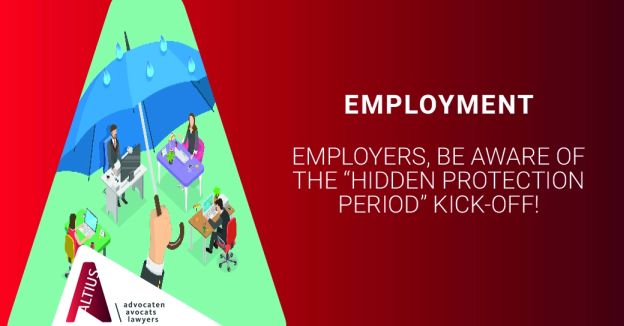
January 10, 2024
The “hidden protection period” is one of the most remarkable features of the social elections process. The hidden protection period is the period during which candidates already benefit from the specific dismissal protection, even though the candidate lists are only being disclosed to the employer 65 days later. Hence, there is a 65 days-gap during which an employer is not aware of an employee's candidacy for the social elections and related dismissal protection, reason why it is highly recommended not to proceed with any dismissals during the hidden protection period to avoid a substantial financial liability.
Depending on your election date, the hidden protection period starts between 14 January and 27 January 2024.
What is the timing of the hidden protection period?
The hidden protection period covers the period between X-30 (i.e. the 30th calendar day preceding the day the employer announces the social elections date) and X+35 (i.e. the day the candidate lists are submitted). This implies that an employer is faced with a hidden protection period of 65 days.
Depending on your election date, the hidden protection period starts between 14 January and 27 January 2024, and ends between 19 March and 1 April 2024.
Check out our personal social elections calendar to verify the hidden protection period in your company.
Why is it called a ‘hidden' protection period?
As the candidate lists are only disclosed to the employer on X+35, the employer does not know before that date which employees are a candidate for the 2024 social elections.
Hence, if an employer terminates an employee during the hidden protection period, it could be that the employer, without being aware, has terminated an employee who later appears to be a candidate for the social elections and was therefore protected against dismissal. That is the reason why the period betweenX-30 and X+35 is called the 'hidden' protection period. Indeed, if in the end on X+35 it appears that this (terminated) employee was a candidate for the social elections, then the employee will retroactively benefit from the dismissal protection as of X-30.
Hence, all employees who meet the legal requirements to be a candidate for the social elections are potentially protected against dismissal during the hidden protection period.
Terminating an employee who is protected against dismissal without compliance with the legal procedures (as set out in the Act of 19 March 1991) can trigger a significant financial liability for the employer.
For the sake of completeness, in certain circumstances the hidden protection period even takes 106 days until X+76 (i.e. the day until which new employees can submit their candidacy to replace other candidates in some limited circumstances as described by law, e.g. in case a candidate dies).

Some practical examples
Case 1: A termination with immediate effect during the hidden protection period
The employer proceeds with a termination with immediate effect on 31 January 2024, i.e. after X-30.

If the employee submits his/her candidacy, the employee will retroactively benefit from the dismissal protection.
Case 2: A termination subject to a prior notice, notified before X–30
The employer proceeded with a termination subject to a prior notice of 13 weeks, served by registered mail to the employee on 3 January 2024, i.e. before X-30. The notice period expires on Sunday 7 April 2024, i.e. after X-30.

The notice was notified to the employee before X-30. Hence, the employer did not violate the dismissal protection (as set out in the Act of 19 March 1991). The employee can still submit his/her candidacy. The employee is protected against dismissal as of X-30 until the notice period expires. Upon expiry of the notice period, the employee has to leave the company.
Case 3: An employee is terminated after X-30 pending a prior notice period that was notified before X-30
The employer proceeded with a termination subject to a prior notice of 13 weeks, served by registered mail to the employee on 3 January 2024, i.e. before X-30. On 31 January 2024, the employer terminates the employment relationship with immediate effect pending the notice period.

The notice was notified to the employee before X-30. Hence, the employer did not violate the dismissal protection (as set out in the Act of 19 March 1991). However, if the employer proceeds with a termination with immediate effect after X-30, pending the notice period, the employee will retroactively benefit from the dismissal protection if he/she submits his/her candidacy.
Case 4: An employee is terminated for serious cause after X-30.
An employer terminates an employee on 31 January 2024 for serious cause. On X+35 it appears that this employee is a candidate for the social elections. The employee retroactively benefits from the dismissal protection (as set out in the Act of 19 March 1991). This implies that the termination for serious cause was not legally implemented on 31 January 2024 as the employer first had to obtain a recognition from the labour court that the facts indeed qualify as a serious cause prior to implementing the dismissal.
As compliance with this prior dismissal procedure is practically not possible, for the simple reason that the employer does not know at the moment it proceeds with the termination for serious cause that the employee is protected, case law has developed a pragmatic solution to tackle this procedural issue: if an employee is terminated for serious cause and on X+35 it turns out that this employee was a candidate for the social elections, the employer should accept the re-instatement request of such an employee under reservation of initiating the procedure within 3 working days to obtain recognition of the serious cause.
What are the risks?
Any employee who is a candidate for the social elections and whose employment is terminated during the hidden protection period is entitled to a protection indemnity (i.e. a fixed and a variable portion) provided that he/she requests his/her re-instatement in time, i.e. within 30 calendar days following the day the candidate lists are submitted, and the employer refuses such re-instatement.
However, if the employee does not request for his/her re-instatement or if the employee requests for his/her re-instatement but the employer accepts this re-instatement, no protection indemnity will be due. It is only when the employer refuses the re-instatement that a protection indemnity will be due.
In summary, depending on the situation, when terminating a protected employee during the hidden protection period, the liability is as follows:
| Fixed portion due? | Variable portion due? | |
| The employee requests for his/her re-instatement and the employer accepts. | No | No |
| The employee requests for his/her re-instatement and the employer refuses. | Yes | Yes |
| The employee does not request for his/her re-instatement. | No This constitutes a difference with the liability an employer incurs if it proceeds with the employment termination of a protected employee outside the hidden protection period, where the employer in any event is liable for the payment of the fixed portion of the protection indemnity if the terminated employee does not request for his/her re-instatement. |
No |
If the protection indemnity (i.e. the fixed and variable portion) is due, the liability for the employer is as follows:
- The fixed portion of the protection indemnity:
| Length of service < 10 years | 2 years' salary |
| Length of service ≥ 10 years but < 20 years | 3 years' salary |
| Length of service ≥ 20 years | 4 years' salary |
- The variable portion of the protection indemnity:
| The salary until the mandate's expiry (i.e. 2 years or 4 years, depending on whether this is the employee's first candidacy). |
Ultimately and as indicated, the employer can entirely avoid the financial liability if it accepts the request for re-instatement.
Practical recommendation
It is highly recommended to avoid making dismissals during the hidden protection period (as all employees who meet the eligibility conditions for being a candidate for the social elections are potentially protected). If an employer does proceed with a dismissal during that period, then it is likely that a dismissed employee will submit his or her candidacy for the social elections. By doing so, the employee will retroactively benefit from the dismissal protection, triggering a substantial financial liability for the employer.
In practice, we often see that employers try to challenge the validity of the candidacy of such a terminated employee based on a so-called abusive candidacy. However, the labour courts do not easily declare such a claim to be founded.
The content of this article is intended to provide a general guide to the subject matter. Specialist advice should be sought about your specific circumstances.



